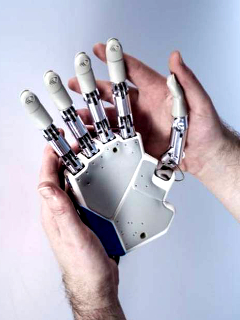Artificial skin feels real pain
 Researchers have developed electronic artificial skin that reacts to pain.
Researchers have developed electronic artificial skin that reacts to pain.
The prototype device developed by a team at RMIT University can electronically replicate the way human skin senses pain.
The device mimics the body’s near-instant feedback response and can react to painful sensations with the same lighting speed that nerve signals travel to the brain.
Lead researcher Professor Madhu Bhaskaran said the pain-sensing prototype was a significant advance towards next-generation biomedical technologies and intelligent robotics.
“Skin is our body’s largest sensory organ, with complex features designed to send rapid-fire warning signals when anything hurts,” Dr Bhaskaran said.
“We’re sensing things all the time through the skin but our pain response only kicks in at a certain point, like when we touch something too hot or too sharp.
“No electronic technologies have been able to realistically mimic that very human feeling of pain – until now.
“Our artificial skin reacts instantly when pressure, heat or cold reach a painful threshold.
“It’s a critical step forward in the future development of the sophisticated feedback systems that we need to deliver truly smart prosthetics and intelligent robotics.”
As well as the pain-sensing prototype, the research team has also developed devices using stretchable electronics that can sense and respond to changes in temperature and pressure.
Dr Bhaskaran, co-leader of the Functional Materials and Microsystems group at RMIT, said the three functional prototypes were designed to deliver key features of the skin’s sensing capability in electronic form.
With further development, the stretchable artificial skin could also be a future option for non-invasive skin grafts, where the traditional approach is not viable or not working.
“We need further development to integrate this technology into biomedical applications but the fundamentals – biocompatibility, skin-like stretchability – are already there,” Dr Bhaskaran said.
Provisional patents have been filed for a combination of three technologies previously pioneered and patented by the team:
- Stretchable electronics: combining oxide materials with biocompatible silicone to deliver transparent, unbreakable and wearable electronics as thin as a sticker
- Temperature-reactive coatings: self-modifying coatings 1,000 times thinner than a human hair based on a material that transforms in response to heat
- Brain-mimicking memory: electronic memory cells that imitate the way the brain uses long-term memory to recall and retain previous information
Details are available in this scientific report.







 Print
Print